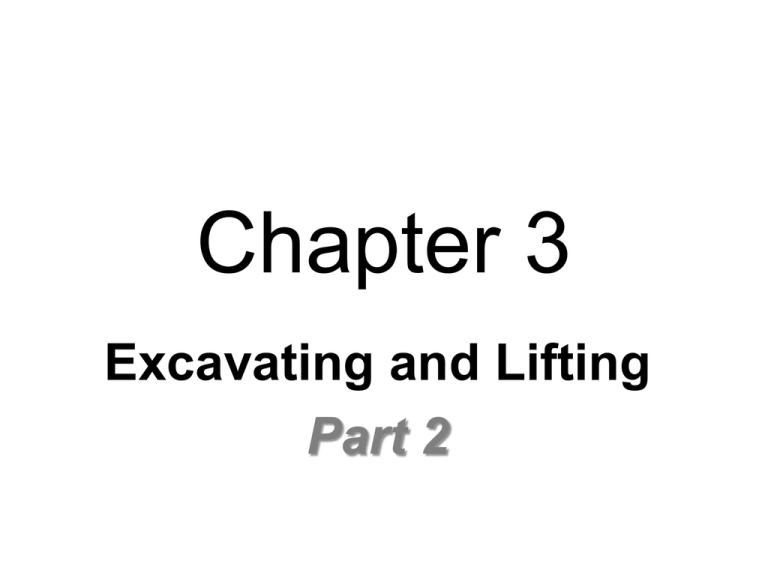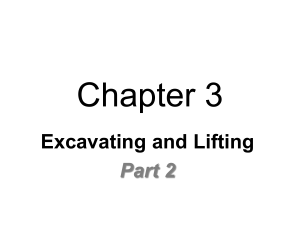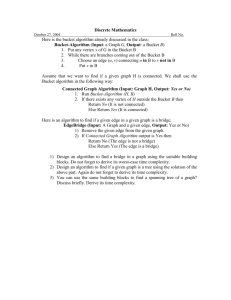
Chapter 3
Excavating and Lifting
Part 2
3-4 DRAGLINES
• Operation and Employment
• Production Estimating
• Job Management
Operation and Employment
• The dragline is a very versatile machine that
has the longest reach for digging and
dumping of any member of the crane-shovel
family.
• It can dig from above machine level to
significant depths in soft to medium-hard
material. The components of a dragline are
shown in Figure 3-10.
FIGURE 3-10: Components of a dragline.
3-4 DRAGLINES
• Bucket teeth and weight produce digging
action as the drag cable pulls the bucket
across the ground surface.
• Digging is also controlled by the position at
which the drag chain is attached to the bucket
(Figure 3-11).
• The higher the point of attachment, the
greater the angle at which the bucket enters
the soil.
FIGURE 3-11: Dragline bucket.
3-4 DRAGLINES
• During hoisting and swinging, material is
retained in the bucket by tension on the dump
cable.
• When tension on the drag cable is released,
tension is removed from the dump cable,
allowing the bucket to dump.
3-4 DRAGLINES
• Buckets are available in a wide range of sizes
and weights, solid and perforated.
• Also available are archless buckets which
eliminate the front cross-member connecting
the bucket sides to provide easier flow of
material into and out of the bucket.
3-4 DRAGLINES
• While the dragline is a very versatile
excavator, it does not have the positive
digging action or lateral control of the shovel.
• Hence the bucket may bounce or move
sideways during hard digging.
3-4 DRAGLINES
• Also, more spillage must be expected in
loading operations than would occur with a
shovel.
• While a skilled dragline operator can
overcome many of these limitations, the size
of haul units used for dragline loading should
be greater than that of those used with a
similar-size shovel.
3-4 DRAGLINES
• The maximum bucket size to be used on a
dragline depends on machine power, boom
length, and material weight.
• Therefore, use the dragline capacity chart
provided by the manufacturer instead of the
machine's lifting capacity chart to determine
maximum allowable bucket size.
Production Estimating
• The Association of Equipment Manufacturers
[formerly the Construction Industry
Manufacturers Association (CIMA)], through its
PCSA Bureau, has made studies of cableoperated dragline operations and has
developed production tables that are widely
used by the construction industry.
• Tables 3-7 to 3-9 are based on PCSA data.
Note, however, that these tables are applicable
only to diesel-powered, cable-operated
draglines.
3-4 DRAGLINES
• To estimate dragline production using the
tables,
– determine the ideal output of the dragline for the
machine size and material (Table 3-7),
– then adjust this figure by multiplying it by a swingdepth factor (Table 3-9) and a job efficiency factor,
as shown in Equation 3-3.
• Expected production = Ideal output × Swing-depth factor
× Efficiency
(3-3)
– Notice the conditions applicable to Table 3-7 given
in the footnote..
3-4 DRAGLINES
• To use Table 3-9 it is first necessary to
determine the optimum depth of cut for the
machine and material involved from Table 3-8.
Next, divide the actual depth of cut by the
optimum depth and express the result as a
percentage.
3-4 DRAGLINES
• The appropriate swing-depth factor is then
obtained from Table 3-9, interpolating as
necessary.
• The method of calculating expected hourly
production is illustrated in Example 3-4.
EXAMPLE 3-4
Determine the expected dragline production in
loose cubic yards (LCM) per hour based on
the following information.
Dragline size = 2 cu yd (1.53 m3)
Swing angle = 120o
Average depth of cut = 7.9 ft (2.4 m)
Material = common earth
Job efficiency = 50 min/h
Soil swell = 25%
EXAMPLE 3-4
Solution
Ideal output =230 BCY/h (176 BCM/h)
(Table 3-7)
Optimum depth of cut = 9.9 ft (3.0 m)
(Table 3-8)
Actual depth/optimum depth = 7.9/9.9 × 100
= 80%
[= 2.4/3.0 × 100
= 80%]
EXAMPLE 3-4
Swing-depth factor=0.90 (Table 3-9)
Efficiency factor =50/60 = 0.833
Volume change factor = 1 + 0.25 = 1.25
Estimated production = 230 × 0.90 × 0.833
×1.25 = 216 LCY/h
[= 176 × 0.90 × 0.833
×1.25 = 165 LCM/h]
Job Management
• Trial operations may be necessary to
select the boom length, boom angle,
bucket size and weight, and the
attachment position of the drag chain that
yield maximum production.
• As in shovel operation, maximum
production is obtained with a minimum
swing angle.
Job Management
• In general, the lightest bucket capable of
satisfactory digging should be used, since
this increases the allowable bucket size
and reduces cycle time.
• It has been found that the most efficient
digging area is located within 15° forward
and back of a vertical line through the
boom point, as illustrated in Figure 3-12.
Job Management
• Special bucket hitches are available which
shorten the drag distance necessary to
obtain a full bucket load.
• Deep cuts should be excavated in layers
whose thickness is as close to the
optimum depth of cut as possible.
FIGURE 3-12: Most efficient digging area for a dragline
3-5 CLAMSHELLS
• Operation and Employment
• Production Estimating
• Job Management
3-5 CLAMSHELLS
Operation and Employment
• When the crane-shovel is equipped with a
crane boom and clamshell bucket, it becomes
an excavator known as a clamshell.
• The clamshell is capable of excavating to
great depths but lacks the positive digging
action and precise lateral control of the
shovel and backhoe.
3-5 CLAMSHELLS
• Clamshells are commonly used for :
– excavating vertical shafts and footings,
– unloading bulk materials from rail cars and ships,
and
– moving bulk material from stockpiles to bins,
hoppers, or haul units.
3-5 CLAMSHELLS
• The components of a cable-operated
clamshell are identified in Figure 3-14.
Clamshell attachments are also available for
the hydraulic excavator.
• A clamshell bucket is illustrated in Figure
3-14.
• Notice that the bucket halves are forced
together by the action of the closing line
against the sheaves.
FIGURE 3-13: Components of a Clamshell
FIGURE 3-14: Clamshell bucket
3-5 CLAMSHELLS
• When the closing line is released, the
counterweights cause the bucket halves to
open as the bucket is held by the holding line.
• Bucket penetration depends on bucket weight
assisted by the bucket teeth.
3-5 CLAMSHELLS
• Therefore, buckets are available in light,
medium, and heavy weights, with and without
teeth.
– Heavy buckets are suitable for digging medium
soils.
– Medium buckets are used for general-purpose
work, including the excavation of loose soils.
– Light buckets are used for handling bulk
materials such as sand and gravel.
3-5 CLAMSHELLS
• The orange peel bucket illustrated in Figure
3-15 is principally utilized for underwater
excavation and for rock placement.
• Because of its circular shape, it is also well
suited to excavating piers and shafts.
• It operates on the same principle as does the
clamshell.
FIGURE 3-15: Orange peel bucket.
(Courtesy of ESCO Corporation)
3-5 CLAMSHELLS
Production Estimating
• No standard production tables are available
for the clamshell.
• Thus production estimation should be based
on the use of Equation 2-1.
• The procedure is illustrated in Example 3-5.
EXAMPLE 3-5
• Estimate the production in loose cubic
yards per hour for a medium-weight
clamshell excavating loose earth. Heaped
bucket capacity is 1 cu yd (0.75 m3). The
soil is common earth with a bucket fill
factor of 0.95. Estimated cycle time is 40
s. Job efficiency is estimated at 50 min/h.
EXAMPLE 3-5
Solution
Production = 3600/40 × 1 × 0.95 × 60/50
= 71 LCY/h
B = 3600/40 × 0.75 × 0.95 × 60/50
= 53 LCM/h
Job Management
• The maximum allowable load (bucket
weight plus soil weight) on a clamshell
should be obtained from the
manufacturer's clamshell loading chart for
continuous operation.
Job Management
• If a clamshell loading chart is not available,
limit the load to 80% of the safe lifting
capacity given by the crane capacity chart for
rubber- tired equipment or 90% for crawlermounted equipment.
• Since the machine load includes the weight
of the bucket as well as its load, use of the
lightest bucket capable of digging the
material will enable a larger bucket to be
used and will usually increase production.
Job Management
• Tests may be necessary to determine the
size of bucket that yields maximum
production in a particular situation.
• Cycle time is reduced by organizing the
job so that the dumping radius 3-6
Trenching and Trenchless Technology 65
is the same as the digging radius.
Job Management
• Keep the machine level to avoid swinging
uphill or downhill.
• Nonlevel swinging is hard on the machine
and usually increases cycle time.
3-6 TRENCHING AND
TRENCHLESS TECHNOLOGY
• Trenching Machines and Plows
• Trenchless Technology
• Repair and Rehabilitation of Pipelines
3-6 TRENCHING AND
TRENCHLESS TECHNOLOGY
• The use of backhoes and other excavators
for digging trenches was discussed earlier
in this chapter.
• In addition, there is a growing demand for
methods of installing utility systems below
the ground with minimum open
excavation.
3-6 TRENCHING AND
TRENCHLESS TECHNOLOGY
• Some methods available for achieving this
objective include specialized trenching
machines and plows as well as trenchless
technology (also called trenchless
excavation).
• Safety considerations in trenching
operations are discussed in Section 10-6.
3-6 TRENCHING AND
TRENCHLESS TECHNOLOGY
Trenching Machines and Plows
• Some of the types of trenching machines
available include chain trenchers, ladder
trenchers, and bucket wheel trenchers.
• Figure 3-14 shows a large chain trencher
capable of digging 14 to 36 in. (356-914 mm)
wide vertical sided trenches to a depth of 10
ft (3.1 m).
• Ladder trenchers are similar to chain
trenchers but are larger.
FIGURE 3-16: Chain trencher.
(Courtesy of Vermeer Manufacturing Co.)
FIGURE 3-16: Chain trencher.
(©Vermeer Manufacturing Company, All Rights Reserved.)
3-6 TRENCHING AND
TRENCHLESS TECHNOLOGY
• They are capable of digging trenches up to
10 ft (3.1 m) wide and 25 ft (7.6 m) deep.
• Bucket wheel trenchers use a revolving
bucket wheel to cut a trench up to 5 ft (1.5 m)
wide and 9 ft (2.7 m) deep.
3-6 TRENCHING AND
TRENCHLESS TECHNOLOGY
• Plows can be used to cut a narrow trench
and simultaneously insert a small diameter
cable or pipeline in most soils.
• Vibratory plows such as those shown in
Figure 3-17 deliver a more powerful cutting
action than static plows and can be used to
insert utility lines in hard soil or soft rock.
FIGURE 3-17: Hydrostatic vibratory plow.
(Courtesy of Vermeer Manufacturing Company, All Rights Reserved)
Trenchless Technology
• While a number of different techniques are
used in trenchless technology, the
principal categories include pipe jacking,
horizontal earth boring, and
microtunneling.
Trenchless Technology
• The process of pipe jacking (Figure 3-18)
involves forcing pipe horizontally through
the soil.
• Working from a vertical shaft, a section of
pipe is carefully aligned and advanced
through the soil by hydraulic jacks braced
against the shaft sides.
• As the pipe advances, spoil is removed
through the inside of the pipe.
FIGURE 3-18: Installing a utility line by pipe jacking
Trenchless Technology
• After the pipe section has advanced far
enough, the hydraulic rams are retracted
and another section of pipe is placed into
position for installation.
• The process often requires workers to
enter the pipe during the pipe jacking
operation.
Trenchless Technology
• In horizontal earth boring a horizontal hole
is created mechanically or hydraulically
with the pipe to be installed serving as the
casing for the hole.
• Some of the many installation methods
used include auger boring, rod pushing
(thrust boring), rotational compaction
boring, impact piercing, horizontal
directional drilling, and fluid boring.
Trenchless Technology
• A track-mounted thrust boring machine with
percussive hammer action is shown in Figure
3-19.
• Many of these techniques utilize lasers and
television cameras for hole alignment and
boring control.
• A number of types of detectors are available
to locate the drill head and ensure that the
desired alignment and depth are being
maintained.
FIGURE 3-19: Grundodrill & Thrust boring
machine with percussive action.
(Courtesy of TT Technologies, Inc.)
Trenchless Technology
• The use of a pneumatic piercing tool to
create a borehole for a utility line is
illustrated in Figure 3-20.
FIGURE 3-20: Installing a utility line by horizontal earth boring.
Trenchless Technology
• After the bore has been completed, several
methods are available to place pipe into the
borehole.
– In one method, pipe is pulled through the bore
using the tool's air hose or a steel cable pulled by
the air hose.
– Another method uses the piercing tool to push the
pipe through the borehole.
– A third method uses a pipe pulling adapter
attached to the piercing tool to advance the pipe
at the same time as the piercing tool advances
the bore.
Trenchless Technology
• Microtunneling or utility tunneling is similar
to the conventional tunneling described in
Section 8-1 except for the tunnel size and
use.
• Since the tunnels are used for utility
systems rather than for vehicle passage,
they are normally smaller than road or rail
tunnels.
Trenchless Technology
• They differ from other trenchless methods
in their use of a conventional tunnel liner
instead of using the pipe itself as a liner.
• Small moles (see Section 8-1) are
frequently used in creating such tunnels.
Repair and Rehabilitation of
Pipelines
• The repair and rehabilitation of existing
pipelines without excavation is another
form of trenchless technology.
Repair and Rehabilitation of
Pipelines
• While a number of methods exist, most
involve the relining of the existing pipeline
or the bursting of the existing pipe while
inserting a new pipe.
• The relining of a pipeline is accomplished
by pulling a new plastic pipe into the
existing pipe or by inserting a liner into the
existing pipe.
Repair and Rehabilitation of
Pipelines
• When a new pipe is used to reline the
pipe, the resulting pipe must be slightly
smaller than the original pipe.
• Another relining technique involves pulling
a folded liner into the existing pipe,
expanding the liner, treating the liner with
an epoxy, and curing it in place.
Repair and Rehabilitation of
Pipelines
• Pipe bursting (Figure 3-21) uses a highpowered hydraulic or pneumatic piercing
tool equipped with a special bursting head
to shatter the existing pipe and enlarge the
opening.
• A new, often larger, pipe is then pulled into
the opening by the piercing head.
FIGURE 3-21: Schematic of pneumatic pipe
bursting method.
(Courtesy of Earth Tool Company LLC)
FIGURE 3-21: Schematic of pipe bursting.
(Courtesy of Vermeer Manufacturing Co.)





